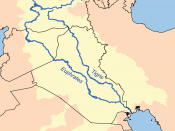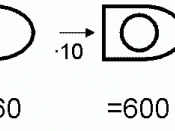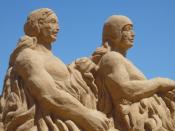Around 3,000 B.C., the Sumerians began to colonize the fertile valleys between the Tigris and Euphrates Rivers. This area was called Mesopotamia, which in Greek means, "land between the rivers." Through their developments of writing, architecture, economy, government, religion, agriculture, and technology, the Sumerians created what we know today as civilized life.
The greatest achievement of the Sumerians was the invention of cuneiform style writing. They would engrave their picture words using reeds as a writing instrument on wet clay, which would then dry into stone-hard tablets. Eventually, they converted their picture words to a short-hand consisting of wedged lines created by bending the reed against the wet clay and moving the end closest to the hand back and forth once. We still use a short-hand form of writing today.
The Sumerians architectural achievements were most impressive. They were masters of construction using bricks made of mud. They developed vast extensive buildings, elaborate brick house, palaces, and temples.
The Sumerians developed the arch and the column. These accomplishments greatly influenced our civilization.
Mesopotamia was divided into independent city-states. The cities were centers of trade. Their economy relied heavily on foreign and domestic trade. Trade and commerce developed in Mesopotamia, because the farmers grew more food than they could eat. They used the surplus to trade for goods and services. Many aspects of our modern enterprise economy have their roots in the early civilizations of Mesopotamia.
The Sumerians seem to have developed one of the worlds first systems of monarchy. Because their government was based on religion, a priest-king administered the laws, which they believed came from the gods. Among his duties, the priest-king led the military, administered trade, judged disputes, and engaged in the most important religious ceremonies. The priest-king was much like our modern day elected president.


